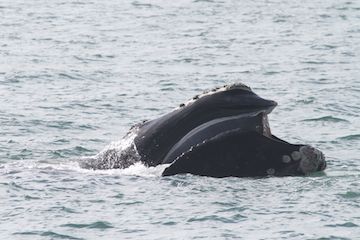380715-in fine voice.jpg

North Atlantic right whale Credit: Georgia Department of Natural Resources.
Researchers may not be ready to hold a conversation with them just yet, but they say they can identify a small group of right whales just by the sounds of their voices. That may provide new insights into the behavior of these endangered giants.
The researchers studied North Atlantic right whales, which are found off the coast of Canada and the United States. They once numbered in the thousands, but whalers decimated the population. In fact, legend says that right whales got their name because they were the “right” whales to hunt — they were slow and docile, and stayed close to land. Today, only 400 or so North Atlantic right whales remain.
Like many whales, they make distinctive sounds — about a half-dozen whistles, moans, and grunts that allow the whales to communicate. Scientists at Syracuse University analyzed more than a decade of whale sounds, which were recorded by sensors strapped to the whales’ backs. In particular, they concentrated on a sound known as the “up-call.” It’s the whale equivalent of saying, “Here I am — what’s up?” It’s used by both sexes and by all ages.
The researchers found that the sound is a little different for each whale. There are differences in the length of the up-call, in the starting and ending pitch, and so on. Analyzing those differences allowed the scientists to identify 13 whales based on their calls. So while they may not yet understand what each whale is saying, they can at least tell who’s doing the talking.

